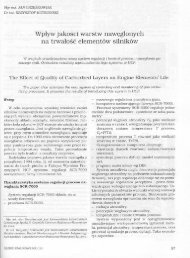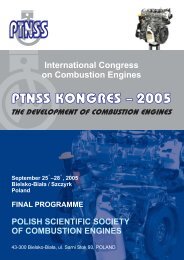You also want an ePaper? Increase the reach of your titles
YUMPU automatically turns print PDFs into web optimized ePapers that Google loves.
Fiber optic-based in-cylinder pressure sensor for advanced engine control and monitoring<br />
sensor that has so far enabled a 3.0 mm thick<br />
cylinder head gasket [11].<br />
The detection principle of the pressure<br />
sensor glow plug (PSG) [12] currently in use<br />
in series production light duty diesel engines<br />
relies on the heating rod axial displacement<br />
associated with changing cylinder pressure<br />
transmitting the motion to deflect the device<br />
diaphragm with a piezoresistive silicon strain<br />
gauge located on the of glow plug top. While<br />
the PSG offers good performance at high pressures<br />
and no thermal shock error, its springmass<br />
principle is inherently prone to artefacts<br />
associated with engine vibration as well as<br />
valve and fuel injector actuation. The notch<br />
filter used by the sensor electronics dampens<br />
the heater axial resonance limiting at the same time knock<br />
detection capability required for applications in gasoline or<br />
gas engines.<br />
A number of so called stand-alone CPS intended for<br />
mounting into a dedicated port drilled in the engine head has<br />
been under development for the last few years focusing on<br />
applications in emerging gasoline HCCI and similar engines.<br />
One sensor type is based on a piezoceramic load cell [13] responding<br />
to the pressure-related changes of the device stress<br />
loading. However, this sensor suffers from susceptibility to<br />
engine valve actuation and vibration artifacts, sensitivity to<br />
sealing torque, and temperature and drift errors. Another<br />
type of the stand alone CPS operates on the same principle<br />
as the PSG suffering from the same limitations associated<br />
with the device spring-mass principle. As a result, the sensor<br />
has poor low pressure detection accuracy and distorted<br />
frequency response prohibiting high fidelity detection of<br />
engine knock and engine control strategies based on low<br />
cylinder pressure signal.<br />
In contrast to the CPS designs based on either piezoresistive<br />
or piezoceramic sensors, which both measure pressure<br />
indirectly, the fiber optic-based sensor described here relies<br />
on the direct effect of combustion pressure, which defects<br />
sensor diaphragm located in the device tip [14]. The design<br />
enables high detection accuracy over a wide frequency range<br />
and at low pressure during compression where alternative<br />
CPS technologies suffer from engine vibration artifacts.<br />
However, the direct exposure of sensor diaphragm to combustion<br />
gasses and associated rapid temperature changes are<br />
the sources of so called thermal shock error that needs to be<br />
minimized to attain high detection accuracy at low pressure<br />
during expansion cycle.<br />
3. Description of fiber optic-based pressure sensor<br />
Fig. 1. Schematic diagram of fiber optic-based pressure sensor<br />
The schematic diagram of the fiber-optic cylinder pressure<br />
sensor [14] Optrand has developed is shown in below<br />
(Fig. 1).<br />
The sensor head, which can vary in diameter from 1.8<br />
mm to 10 mm depending on the diaphragm diameter, consists<br />
of stainless steel housing with a welded hat-shaped<br />
diaphragm made of Inconel 718 alloy and a metal ferrule<br />
with two optical fibers sealed inside. By an optimum selection<br />
of diaphragm thickness and geometry its fatigue life can<br />
be as high as 5 billion cycles and possibly more. The most<br />
recent improvement of the fiber to ferrule seal relies on a<br />
hermetic glass bond rated for the maximum temperature of<br />
either 420 o C or 510 o C enabling the maximum sensor tip<br />
temperature of 380 o C or 480 o C, respectively. The other<br />
fiber ends are connected to the sensor signal conditioner. The<br />
diaphragm’s inside surface is illuminated by the “delivering”<br />
fiber connected to a light source while the “receiving”<br />
fiber transmits light reflected from the diaphragm to a light<br />
detector. During sensor assembly the ferrule is advanced<br />
toward the diaphragm until the target gap is reached, at which<br />
time the ferrule is welded to the housing. Figure 2 shows<br />
examples of sensor head packages based on the 1.7 mm<br />
diameter diaphragms with different thicknesses – dependent<br />
of engine peak pressures, targeting integration with such<br />
engine components as a glow plug, cylinder head gasket,<br />
spark plug, or fuel injector.<br />
Fig. 2. Examples of sensor heads based on 1.7 mm diameter diaphragm<br />
The key components of the sensor signal conditioner<br />
are an LED light source, a photodiode photo detector, and<br />
SMT electronic parts. Two large core fibers are permanently<br />
bonded to the LED (850 nm wavelength, 100 micron emitting<br />
area, point-source type) and photodiode (Silicon) chips. The<br />
Auto-Referencing circuitry [14] regulates the LED light intensity<br />
in a closed-loop control scheme so that the sensor offset<br />
is kept constant as the sensor head and signal conditioner<br />
temperatures change. In combination with the Temperature<br />
Compensation technique [14], closed loop LED control also<br />
corrects for the temperature dependence of sensor sensitivity<br />
associated with the diaphragm’s deflection temperature<br />
4 <strong>COMBUSTION</strong> <strong>ENGINES</strong>, No. 4/2012 (151)












